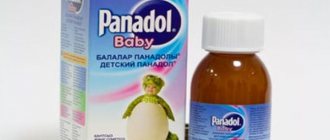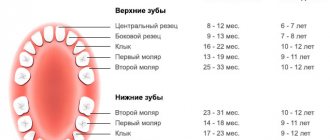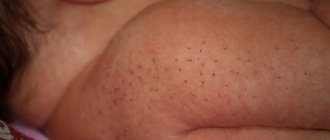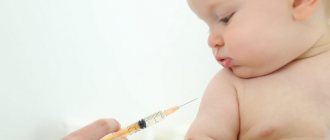Swollen gums in a baby
When a newborn is born, his parents will have to learn how to care for the little one and closely monitor his health. At first, many of them face sleepless nights and colic, and a little later the time comes for new teeth to appear.
If the baby is naughty, the mother should look into the baby’s mouth and look at his gums in anticipation of the first tooth. However, swelling of the gums can be a sign not only of the eruption of baby teeth, but also of certain diseases.
Why can gums be blue?
The acquisition of a blue tint by the gums at the site of the eruption of a new tooth is called cyanotic
.
Its appearance is associated with squeezing or rupture of small blood vessels when the tooth moves to the surface of the gum. If the area of blueness is small, this situation usually does not require any intervention.
If the blue area of the gum is large, the child should be shown to the dentist, as this may be a sign of hematoma formation. You should go to the clinic with your baby so that the doctor will make a small incision and release the blood that has collected under the surface of the gum.
Most often, problems occur during the eruption of chewing teeth.
Lower incisors are less painful to cut than upper incisors.
Causes
The main and most common cause of gum swelling in infants in the first year of life is the appearance of teeth. Unfortunately, many children have a hard time with the eruption of their baby teeth. They suffer from pain, increased salivation and constant itching. Some babies teething with a high fever and other unpleasant symptoms.
Note that the first signs that the baby will soon erupt a tooth may appear two or even four weeks before it “pecks.”
Most toddlers please their parents with their first teeth at 5-6 months of age , but depending on the individual characteristics of some infants, the first tooth may appear several months earlier, while others acquire their first incisors only by their first birthday.
Mom may notice swelling of the baby’s gums in the following situations:
- The baby developed caries. This disease can affect even the first teeth of a toddler if parents neglect to carefully care for the baby’s oral cavity, lick the pacifier or spoon given to the baby, or allow the child to drink sweet tea or compote at night. Bacteria accumulating on the surface of baby teeth destroy the enamel, and if you do not immediately show the baby to the dentist and do not treat the teeth, the risk of further spread of infection increases, which sometimes ends in tooth loss.
- The baby contracted stomatitis. The disease can be provoked by bacteria, viruses, fungi (they most often affect the gums of children under one year of age) and other causes. In addition to swelling of the gums, stomatitis in an infant is manifested by the appearance of plaque, rashes or spots on the oral mucosa. The baby’s general condition may deteriorate greatly and the temperature often rises.
- The baby damaged his gums with something sharp or hard. As a result of such an injury, the gum mucosa may become inflamed, which will manifest itself as an increase in size, increased bleeding and pain.
- The baby does not have enough vitamin C or other nutrients. This situation can also lead to problems with the gums, making them looser, enlarged and prone to bleeding.
How does a tooth erupt?
A child's gums begin to change long before the tooth emerges. Their tissues become looser and change color. The gums in the place where the tooth will soon appear swell and increase slightly in size.
As for the color change, in most cases there is redness, but in some babies the color may be bluish, burgundy or dark purple.
When the erupting tooth comes close to the surface of the gum, parents see a white dot.
It is a tooth visible through thinning gums. This is followed by the final stage of eruption, during which the crown of the tooth passes through the gum and the tooth is freed from its tissues. This is helped by the enzymes present in the child’s saliva, which literally “melt” the gum and give the tooth the opportunity to appear on its surface.
Saliva promotes the rapid emergence of the tooth crown from the baby’s gums
What to do
The actions of parents who discover swelling of the gums in their infant will depend on the cause of such changes in the oral cavity. If the baby behaves restlessly, suffers from pain, fever and other unfavorable symptoms, the child should be shown to a pediatric dentist. The doctor will examine the baby’s mouth and determine whether the swelling is due to teething or is a disease that needs to be treated.
During teething
To relieve soreness and itching in the gums of a toddler, parents should purchase special toys for the baby, called teethers. also massage the gums with a clean finger, and if the baby is in severe pain, special preparations with a cooling and anesthetic effect are used, which are produced in the form of a gel.
For caries
If a dentist identifies this disease in an infant, it is important to treat it immediately to prevent further destruction of dental tissue. The treatment method will depend on the stage and severity of the infection. Many children have their teeth silvered or treated with fluoride preparations, and sometimes they have to resort to removing infected tissue and filling them.
For stomatitis
In the treatment of such a disease, they first try to determine its cause, since for herpes stomatitis, antiviral drugs are prescribed, bacterial stomatitis is affected by antimicrobial agents, and for candidal stomatitis, drugs that affect fungi are indicated. Also, a child diagnosed with stomatitis should treat the oral cavity with antiseptic solutions and anti-inflammatory gels.
Symptoms of gum inflammation
The first problems with teeth begin in a person in infancy, when these same teeth come out. They continue into preschool age, when you want to put everything in your mouth, but you don’t like brushing your teeth at all. Schoolchildren's baby teeth change, which is also accompanied by troubles.
It is not difficult to notice gum inflammation in a child. The condition is accompanied by the following symptoms:
- Redness. It can be localized in one place or spread over the entire surface.
- Swelling. The inflamed area of the gum increases in size. In some forms of gingivitis, a growth may appear on the gum.
- Pain. During teething, repeated pain causes the baby to cry and be capricious. Inflammatory gum disease is most often characterized by aching pain.
- Itching, burning. There is a desire to scratch the sore spot.
- Increased body temperature. The child's temperature rises to 38 degrees.
- Bad breath. It rarely appears during teething and serves as a sign of infection. A strong odor from the mouth is characteristic of advanced gingivitis.
In infants, gum inflammation is more difficult to detect, because the infant cannot yet complain of pain.
Inflammation of the gums - gingivitis
Parents often associate moodiness and fever with a cold. Older children can talk about their condition.
You can examine your child's mouth at home. Before doing this, you must wash your hands with soap. Then you can try to relieve redness and swelling using local remedies. It is best to discuss the use of any medications for an infant with a pediatrician.
Condition of gums during teething in infants: normal and pathological
The appearance of the baby's first teeth is a joy for parents. But quite often the process of teething causes discomfort to the baby and causes negative changes in his condition and behavior. The child becomes capricious, puts various objects in his mouth, cannot fall asleep for a long time, often wakes up and refuses to eat.
During teething, the gums become noticeably swollen, there is redness and severe swelling, and minor hemorrhages and bruises appear. Therefore, parents need to be prepared for possible difficulties, understand the specifics of the problem in advance and respond correctly to all changes in the child’s condition.
Symptoms ↑
The severity and frequency of symptoms accompanying the appearance of baby teeth in children are variable and individual: for some they may be complete, while for others eruption occurs without any discomfort at all.
The main signs of teething:
- local changes (inflammation and looseness of the gums);
- temperature increase;
- excitability;
- runny nose, cough;
- diarrhea.
Gum inflammation
Swollen gums make the baby have a strong desire to scratch them, and he constantly “drags” something into his mouth, actively chews various objects - a pacifier, toys, clothes, a blanket, his own fingers, and can bite the mother’s breast when feeding.
Immediately at the moment of cutting into the tooth, you can see the separation of the gum tissue, accompanied by redness. At this time, the gums are extremely painful, sometimes easily injured (blood appears when you tap a spoon over an emerging tooth, bleeding is possible when chewing).
In some cases, when fangs or molars erupt, even a hematoma (bluish-colored tumor) occurs above the tooth, requiring surgical intervention.
Excitability
Pain, burning sensation, tension in the gums, drooling, and increased temperature during teething are very painful for infants.
Children become restless, capricious, constantly demand attention, and sleep is often disturbed. Many babies become more sensitive to external stimuli: they begin to react painfully to bright lights or loud sounds.
Heat
The increase in temperature during teething is caused by biologically active substances released during the development of local inflammation in the gums.
Prolonged or severe fever in an infant with a temperature greater than 39°C is always suspicious for other illnesses.
Runny nose and cough
A runny nose and cough occur due to a large amount of saliva that flows into the nasopharynx, causing soreness and irritation; at the same time, the glands of the nasal mucosa are activated.
The cough is rare, usually wet, with the release of mucous sputum or saliva. Characteristically, the cough intensifies when the child is lying on his back.
Nasal discharge is also mucous in nature (liquid or semi-liquid, transparent). They flow from the baby’s nose, the baby “grunts” and “squishes,” especially during sleep and while eating. Nasal congestion should not appear.
Digestive disorders
The appearance of the first teeth may be accompanied by a decrease in appetite up to a complete refusal to eat and drink, diarrhea, regurgitation and vomiting.
Decreased appetite is associated with the child’s poor health and pain in the mouth. When the tooth erupts, gum inflammation stops and appetite is restored. Breastfed babies may either refuse the breast or require the breast more frequently than usual, every 15 to 20 minutes.
The stool acquires a semi-liquid or liquid consistency, but its yellow (yellow-brown) color remains. There should be no impurities of blood, mucus, or greenery. Watery stools often cause irritation on the skin of the perianal area.
Regurgitation and vomiting occur as isolated episodes, usually accompanied by high fever. Persistent repeated vomiting, vomiting like a fountain, constant regurgitation is a reason to immediately consult a doctor.
Timing and symptoms of teething
In most cases, the first milk teeth erupt closer to six months, in the period from 4 to 7 months, but there is no single correct time for the start of their growth - everything is individual. Read more about the timing and order of teething→
Timing of eruption and factors influencing them
Often the sequence of appearance, the age at which growth begins and the duration of teething in children are laid down in utero during the formation of the fetal jaw (at 3-4 months of pregnancy). During this period, their size and structure, sequence and age of appearance of the first signs of growth are determined.
Therefore, the course of pregnancy during this period and the absence of unfavorable factors that could change their normal formation are of great importance. The greatest negative impact can be caused by:
- severe maternal illness;
- late toxicosis;
- neuro-allergic disorders;
- metabolic disorders;
- exposure to harmful factors on the embryo (smoking, alcohol, drugs, radiation, poor environmental conditions);
- genetic abnormalities of fetal development;
- intrauterine infection of a child;
- heredity - family predisposition to early and late tooth growth;
- climate features;
- somatic or infectious diseases in the baby.
Symptoms of teething in babies
Symptoms preceding the appearance of the first teeth can be detected long before their true eruption - from 3-4 months. During this period, the baby experiences active salivation, moodiness, and sometimes the gums change before teething - there is slight swelling, looseness, bumpiness and slight redness.
At the same time, the child puts his hands and various objects into his mouth, and his behavior becomes restless, especially in the evening and at night. This is considered the beginning of the passage of bone paths in the gum and the approach of the tooth to the mucous membrane.
Subsequently, repeated redness and swelling of the gums are observed and the following may appear:
- light, clear mucous discharge from the nose (snot);
- rare coughing;
- temperature increase;
- loosening of stool.
Symptoms that appear during this period: the norm and a reason to think about it
For some babies, the process of teething becomes a real challenge, while for others it does not entail any particular difficulties. This is due to the individuality of each child and the presence of associated factors. However, every mother and father wants to know what they might encounter during this period.
Typical signs in this case will be the following:
- an increase in body temperature is a normal reaction to changes occurring in the gums;
- the present discomfort will cause sleep disturbance in the baby, his anxiety and tearfulness;
- there is a special zeal of the baby to put everything in his mouth, this is due to the desire to scratch his gums;
- in the place where the tooth is expected to appear, the gum tissue is swollen and redness is observed;
- the child is capricious while eating, because the process of sucking or eating regular food causes him discomfort;
- there may be a slight runny nose in the form of clear discharge against the background of normal general health, this is due to increased activity of the glands;
- small bumps may appear on the gums, which resolve over time;
- the process of salivation is abundant and, against the background of increased activity of the salivary glands, loose stools are possible.
Teething symptoms
All these symptoms are considered normal, but sometimes there are situations when a mandatory medical examination is required, namely:
- the baby refuses to eat for more than 2 days;
- the runny nose is profuse, and the discharge has a thick, greenish consistency;
- the appearance of frequent and prolonged cough, small cough reflexes are normal, but copious sputum production should alert you;
- diarrhea is prolonged and frequent;
- body temperature is elevated to high levels and does not subside when taking antipyretic drugs.
You can learn more about the symptoms of teething in a child from the video in this article.
Attention: if a child is in serious condition, it is not necessary to visit the clinic with him on his own; you can call an ambulance or a pediatrician at home.
What do gums look like when teething?
By the time the baby is born, the crowns of all his baby teeth are fully formed and are located deep in the alveolar processes of the upper and lower jaw. The process of eruption is a kind of increase in their volume with gradual pushing out.
At the same time, they first overcome the resistance of bone tissue, and then the soft mucous membrane. It is at this time that the gums swell during teething, itching and pain appear at the site of their growth.
What do gums look like before teething? In normal condition, they are pale pink in color for infants. There are no changes (swelling, lumpiness, bleeding, plaque).
In most cases, the eruption picture looks like this:
- During teething in infants, the gums first become loose, a slight bumpiness and redness of the mucous membrane appears. The baby becomes restless, sleeps poorly and refuses to eat. In some cases, external manifestations may be absent - it all depends on the pain threshold and the degree of discomfort in the oral cavity.
- After a certain period of time, swollen gums become more sensitive during teething, a slight hemorrhage appears, and then a small wound forms at the site of growth and the tip of the tooth crown appears.
A small bruise on the gum during teething is not a reason to panic. In most cases, this phenomenon goes away completely as soon as the baby’s tooth approaches the surface of the tissue.
How can you help your baby with teething?
It is simply unthinkable to ignore the baby’s pain and discomfort, because the little person counts on help and support.
In this case, it is permissible to use the following methods:
- The use of local anesthetics to help reduce the manifestation of the inflammatory process and reduce pain.
- Taking antipyretic medications to reduce body temperature . Most often they are based on paracetamol or ibuprofen, which helps with gum soreness and hyperthermia.
- Teethers. They come filled with gel or water and are special children's devices to relieve itching and reduce swelling with pain. It is worth purchasing only at trusted retail outlets and always after reading the quality certificate. A gentle massage also helps in this case.
- Traditional medicine methods . Decoctions based on chamomile, lemon balm, mint, sage or lavender are prepared, but consult your doctor first.
Teethers
Preparations to facilitate teething
Special gels for gums during teething in babies help with the appearance of teeth and have a pronounced anesthetic effect due to the lidocaine included in the composition. In some pharmacy versions, it is possible to add mint, which additionally cools the gums and gives a pleasant aftertaste.
There are many drugs for this purpose, some of them are discussed in the table below:
| Name | Description | From what age can it be used? | approximate price |
| Kalgel | It has a good analgesic effect and is a fairly popular product among its analogues. Also has antimicrobial and anti-inflammatory effects | From 5 months | 250 rubles |
| Dentinox | Due to chamomile extract and small doses of anesthetic, a pronounced and long-lasting analgesic effect is achieved. In addition, there is no sugar, which allows you to preserve emerging teeth and protect them from caries. | From 1 year (younger according to doctor's indications) | 200 rubles |
| Kamistad | This gel contains lidocaine and chamomile flower extracts, which promotes rapid healing of gum tissue, relieves inflammation and pain, as well as a good antiseptic effect. | From 3 months | 210 rubles |
| Holisal | It is produced on the basis of choline, which, in addition to the local analgesic effect, helps reduce temperature. It has a pronounced anise smell and is used 2-3 times a day before the baby eats food. | From 1 year (younger according to doctor's indications) | 300 rubles |
| Doctor Baby | Can be used if you are allergic to lidocaine. Contains plant components - marshmallow root, chamomile, calendula, plantain and echinacea. This allows you to relieve inflammation, relieve some pain and speed up gum healing. | From 3 months | 350 rubles |
Wisdom teeth coming through, gum pain, what to do
Gum massage
Another common method is to massage the gums during teething to relieve pain, relieve itching, improve blood circulation and speed up teething.
All technology is based on the following actions:
- Trim your nails carefully and rinse your hands well, paying special attention to the area under the nails.
- Treat your hands with an antiseptic (miramistin, chlorhexidine).
- Begin massaging with smooth movements exclusively over the gums, starting with stroking back and forth in the area of the painful area and gradually approaching the future tooth. Under no circumstances should movements be made on the cutting surface itself. It is better to perform it with your index finger, thumb or little finger.
- The total duration of the massage is 15 minutes, and you can take breaks so that the baby has time to get used to it.
- All movements should be careful and light so as not to injure the mucous surface.
You should know that this massage also has contraindications. It is also not recommended to carry it out an unlimited number of times.
Gum massage
Possible complications
In some cases, complications during the growth of baby teeth are possible. These include:
- Blue gums in a child during teething and/or bruising. These signs indicate the difficulty of teething in the area of the soft mucous membrane - the gums turn blue during teething, a hematoma and persistent swelling of the soft tissues appear. The baby experiences severe pain, does not sleep and constantly behaves restlessly.
- Attachment of infection. Signs of a local infectious process (viral, bacterial or fungal flora) on the mucous membrane of the gums at the site of eruption and in the oral cavity include:
- white or grayish-yellowish coating;
- rashes in the form of millet grains;
- minor erosions.
How many days does it take for gums to swell?
The duration of symptoms varies from person to person. It depends on the speed of eruption and the presence of complications. A slight swelling may appear almost a month before the tooth itself appears. In this case, the baby’s well-being will be normal.
Symptoms intensify immediately before the tooth emerges from the gum surface. Normally, severe swelling and swelling of the soft tissues disappear within 3-4 days. In different cases, these terms may vary.
How to reduce discomfort?
Methods to reduce discomfort during teething are different and their effect is individual. Often used:
- special anesthetic gels containing various local anesthetics (Dentinox, Kalgel, Bobodent and others);
- teethers (various models made of soft plastic, filled with water), which reduce discomfort but do not injure the mucous membrane;
- in case of severe anxiety and pain, the use of painkillers with ibuprofen and paracetamol (suppositories or syrup) in an age-appropriate dosage is allowed;
- the use of anti-inflammatory decoctions of medicinal herbs - treating the gums with a soda solution, a decoction of sage, chamomile or oak bark.
How to relieve a baby’s condition if his gums are swollen and painful?
When the gums are swollen and unpleasant symptoms appear, many pharmacological innovations come to the aid of children and parents that relieve pain and discomfort. You can use traditional medicine recipes that also helped our mothers and grandmothers.
First of all, you need to get a teething toy. It is first placed in the refrigerator or freezer - the cold rubber toy dulls the pain and safely scratches the gums.
If symptoms are intense, especially when the child does not sleep at all and cries a lot, a variety of gels, suppositories or suspensions are suitable.
Homeopathic medicines are popular and should reduce general symptoms.
Medicines
Medicines for children are divided into the following groups:
- local painkillers;
- complex homeopathy;
- painkillers for oral administration.
Local analgesics are presented in gels; almost all modern parents have them in their medicine cabinet. The advantages of such gels include convenient application to the gums, quick effect and antiseptic properties. During the first minute, the mucous membrane “freezes” and becomes insensitive. Among the disadvantages are the short duration of the effect and unpleasant sensations in the mouth. However, the pain relief effect is sufficient until the child falls asleep.
The most famous gels:
- Kamistad Gel (Baby);
- Kalgel;
- Dentinox Gel-N;
- Holisal.
Homeopathic medicines act comprehensively. They affect the entire process as a whole, speed it up and alleviate the baby’s condition. Such products contain only natural and safe ingredients, so they are suitable even for the smallest children. They must be used strictly according to the instructions.
Homeopathic medicines:
- Viburkol - candles;
- Dantinorm Baby - drops (composition of Dantinorm Baby and instructions for use);
- Dentokind - tablets (instructions for use of the drug Dentokind);
- Pansoral - gel, etc.
Analgesics and antihistamines intended for internal use are prescribed only by a doctor. Unlike the first two groups, taking these medications is indicated in the presence of serious symptoms or complications:
- Fenistil drops (from birth) and Parlazin (after 1 year) are antihistamines. They are prescribed to relieve and reduce swelling of the mucous membranes in the mouth and nasopharynx, and eliminate itching or burning of the gums. Antihistamines help reduce runny nose and inflammation.
- For severe pain or fever, taking antipyretic drugs (they also act as painkillers) is recommended. Children's (necessarily age-appropriate) suspensions or suppositories based on ibuprofen or paracetamol (Nurofen, Panadol, etc.) are suitable. Before starting to take the medicine, you should consult your pediatrician. He will assess the need for its use and also select the most suitable product.
Folk remedies
- Tea based on chamomile, lemon balm, lavender and catnip will calm the baby and reduce pain. Dry ingredients must be mixed in equal proportions. Pour a tablespoon of the prepared mixture into a glass of boiling water and leave for 10-15 minutes, then strain. You can drink this tea throughout the day.
- Wipe your mouth with a strong decoction of chamomile or make compresses. If the decoction is diluted with water, it can be drunk as tea.
- Clove oil helps children and adults in dentistry. It disinfects and relieves pain. Pure clove oil will burn, so it needs to be diluted with olive or almond oil in a 1.5:1 ratio. Treat the inflamed area with the resulting solution.
- For rubbing or compresses, a decoction of sage, calendula, and oak bark is used. You can use one component or prepare a mixture. The ingredients relieve inflammation, disinfect, reduce pain and itching.
Chamomile tea is a very effective teething soothing remedy.
Precautionary measures
If any alarming symptoms appear (blue gums during teething, severe hemorrhage, increased bleeding), you should contact a pediatric dentist. Sometimes a dissection of the mucosa is required to allow tooth growth.
Under no circumstances should you independently dissect or even massage the area of hemorrhage, especially if the hematoma on the gum during teething is observed over a large area and there is pronounced swelling of the surrounding tissues.
To avoid infectious complications, you need to regularly boil in a soda solution or wash all objects that the baby puts in his mouth (pacifiers, teethers, toys).
If you notice symptoms of infection, you should urgently seek advice from a specialist. During this period, children experience a persistent decrease in local and general immunity, and improper treatment of infectious complications or lack of treatment can lead to dangerous complications.
Author: Olga Sazonova, doctor, especially for Mama66.ru
Why might gums turn black?
The acquisition of a dark color by the gum through which the tooth is cut, which can be blue, purple, crimson or even black, is associated with the formation of a hematoma or eruption cyst in its tissues.
Such manifestations look quite frightening, but often do not cause much discomfort to the child and do not require medical intervention.
The appearance of a cyst or hematoma is most often observed when chewing teeth erupt, and a little less often when fangs or incisors are cut. In the baby’s mouth, parents notice a large formation in the form of a dark ball on the gum. It occurs when a tooth moves up through the gum and injures its tissue, rupturing blood vessels.
The best way out after detecting such changes would be to visit the dentist with your child. Trying to break through the gum on your own or using anything to cut it is strictly prohibited.
To ease your baby’s suffering, be sure to buy a high-quality teething toy.
Depending on the results of the examination, the doctor may recommend allowing the child to chew hard objects that can speed up the tooth’s breakthrough of the mucous membrane and get rid of the hematoma, for example, a teething toy, carrots or crackers. During chewing and physical impact on the gum, the mucous membrane breaks through faster and the tooth comes to its surface.
In some cases, for example, if the hematoma is very large, the child has severe pain, infection or bleeding appears, surgical intervention is resorted to. After local anesthesia, the child’s gums are cut with a special instrument. This facilitates the appearance of the tooth and eliminates the accumulation of blood.
Teething in children and infants
From this article you will learn:
- sequence of teething in children,
- timing of eruption of baby teeth, permanent teeth,
- teething in infants: photos,
- signs of teething in children (symptoms).
Teething in children has a strict order, and must also be in pairs, i.e. identical teeth must erupt at the same time, for example, a pair of central incisors, a pair of lateral incisors or a pair of canines... The timing of teething in children is strictly defined, and their violation indicates a certain pathology.
Teething: photo
Teething is fundamentally no different in infants, infants and older children. What teething looks like in children - you can see in the photo.1-9
Gums during teething: photo
In some cases, 2-3 weeks before the eruption of a baby or permanent tooth, a lump filled with clear or bluish liquid may appear on the gum (Fig. 6-7). This is not a pathology and is not associated with inflammation. No interventions (other than periodic examination) are required. Only when the lump becomes large enough can a small incision be made and thus release the accumulated bloody fluid.
At what age do the first teeth begin to appear?
Doctor's recommendations often imply additional administration of beneficial vitamins to babies along with the consumption of breast milk. In these children, teething occurs as early as 3 months.
.
No one will tell you the exact timing of teething - they simply do not exist and they must erupt without external influence. They depend on the baby’s race, heredity, body condition and other factors. Pediatricians take average periods into account when assessing the overall development of a child.
The normal period for the appearance of the first teeth is 6-8 months. By the first year of life, a baby may already have 8 teeth. By the age of 3, children should already have 20 teeth. If teeth are cut 2-3 months after birth, this should not frighten parents
— this indicator does not go beyond the norm.
What could be the reason for the early appearance of teeth in a baby? This is caused by the mother taking mineral complexes and multivitamins during pregnancy, which include calcium and vitamin D. This is caused by increased consumption of cottage cheese and dairy products.
There are rare cases when the first teeth can appear already in the first month of a baby’s life.
. This should be a reason to contact your pediatrician, who will issue a referral for testing. Abnormally early teeth may indicate disturbances in mineral metabolism in the body.
Teething in children after one year
Even with changes or slight disturbances in hormonal levels, by the age of one year, babies should have 1-2 teeth. If they are absent, then this is a reason for parents to be wary. The delay in the eruption of baby teeth in infants is influenced by the following factors:
- rickets;
- weakened immune system;
- pathology of the endocrine system;
- early or too late introduction of complementary foods;
- allergy to cottage cheese and eggs;
- prematurity;
- hereditary predisposition;
- edentulous
We have already written about a detailed teething scheme, so it would be a good idea to further familiarize yourself with this information to complete the picture.
The timing and order of teething in a child -
The order of eruption of baby teeth is:
A newborn child has 20 follicles of temporary teeth inside the upper and lower jaws, as well as 16 rudiments of permanent teeth (the remaining 16 rudiments of permanent teeth form in the jaws later).
The first teeth to erupt are on the lower jaw. The enamel of children's teeth is more porous and rough; it contains few microelements compared to mature mineralized enamel in adults. Consequently (in the absence of proper hygiene, diet and treatment of teeth with protective varnishes that accelerate mineralization), there is a very high risk of developing multiple dental caries.
Table/Scheme of baby teeth eruption:
Period of eruption of permanent teeth -
You can see the sequence and timing of teething in children (permanent teeth) in diagram No. 2. Of the permanent teeth, the molars are the first to erupt (they are located at the end of the dentition). These teeth have deep fissures (indentations) on the chewing surface, and therefore are especially quickly affected by caries.
Inflammatory gum disease in children
Gums can become inflamed in newborns and adult children. The most common causes of gum disease:
- improper oral hygiene;
- nutritional deficiencies (lack of vitamins and microelements);
- problems with nasal breathing;
- infectious diseases.
Read also: Why does a child have black teeth?
Insufficient oral hygiene creates a favorable environment for the development of bacteria. During infectious diseases, pathogens enter the oral cavity from parts of the respiratory system. If nasal breathing is impaired, the child begins to breathe through the mouth. The mucous membranes dry out, and the antibacterial function of saliva is impaired. This leads to active proliferation of microorganisms.
Causes of gum inflammation
Sometimes gum inflammation in young children is associated with eating soft foods. There is no chewing load on the gums. When teeth appear, it is necessary to give the child solid food - apple slices, pears, bread crusts.
Teething: symptoms
Signs of teething in infants usually begin 3-5 days before teething. The child’s teething symptoms continue until the moment when the teeth appear through the mucous membrane of the gums.
The main symptoms of teething in infants are:
→ swelling, swelling of the gums at the site of eruption, → irritability, → poor sleep, → poor appetite, refusal to eat, → the child tries to bite whatever he can, trying to relieve itching in the gums, → increased salivation, → rash and irritation in the mouth and chin, as well as on the chest (due to drooling from the mouth).
Additional signs of the eruption of the first teeth -
- Teething: Fever – It is rare for a baby to develop a fever during teething. It cannot be above 37.5 degrees. High temperature during teething is most likely a consequence of some concomitant inflammatory process not associated with teething, for example, ARVI or viral stomatitis.
How long does the temperature last during teething: it usually occurs 3-5 days before teething and disappears after the apex of the tooth erupts above the mucous membrane. If a fever occurs during teething in children, a child’s one may be useful here “https://24stoma.ru/wp-content/uploads/2013/08/fa11.jpgHematomas on the mucous membrane of the gums - in some cases, the gums swell and become pronounced bluish color (Fig. 6,7,11). This usually does not require intervention, and only if the hematomas become large, a small incision is made to release the bloody fluid.
- Vomiting during teething - the only cause of vomiting can be that the child has swallowed saliva due to increased salivation. There can be no other reasons. If vomiting occurs against the background of a high temperature, and even more so, stool disturbances, then teething has nothing to do with it and you should immediately suspect rotavirus and urgently call a doctor.
- Cough during teething – Cough is not common during teething. The only reason, as in the previous case, may be increased salivation, i.e. the child may periodically choke on saliva, which may enter the respiratory tract rather than the esophagus.
- Runny nose during teething - a runny nose during teething, of course, can happen, but it is definitely not associated with teething, but with concomitant colds.
To learn how you can help your child feel more comfortable when teething, read the article: → “Medications, recommendations for parents when children are teething”
Signs of pathology
Blue gums during teething sometimes indicate the presence of pathology. It could be:
- hematoma requiring medical intervention;
- anemia;
- gingivitis;
- stomatitis.
If the bruise is more than 2 cm in diameter, then you should consult a doctor. This hematoma is often dark, almost black, due to accumulated blood. It is accompanied by fever and local pain. The doctor makes an incision and releases blood to avoid the development of pathology. Otherwise, it can lead to suppuration, inflammation or cyst formation.
Anemia is caused by a decrease in the level of hemoglobin in the blood, which causes changes in the color of the skin and mucous membranes. Blue discoloration will be noticeable not only on the gums, but also in the area of the lips, nails, and eyes. Anemia is also indicated by: weakness, loss of appetite, susceptibility to infections, cold extremities. This condition is usually caused by a lack of iron and occurs regardless of whether the tooth is erupting at the time or not.
Gingivitis is an inflammatory process in the gums. It usually occurs due to insufficient oral hygiene and is accompanied by itching, bleeding, and swelling. If the child already has teeth, then gingivitis can be caused by carious teeth, mechanical injuries, malocclusion, or a weakened immune system. Sometimes the fact that a tooth is erupting is itself the cause of this type of inflammation, because damaged gums become vulnerable to various bacteria. With gingivitis, the gums turn blue or red, and small ulcers may appear.
Stomatitis is another type of inflammation of the oral mucosa. Sometimes there is a blue tint against the background of redness, which affects not only the gums, but also the oral cavity. It, like gingivitis, is usually caused by the penetration of pathogens into weakened or damaged mucosa and is accompanied by ulcers and pain.
The fact that the gums turn blue during teething may indicate various diseases, while often remaining within the normal range. It is necessary to monitor changes in the child’s behavior and well-being, then it will be easier to determine the root cause of the deviations and take action if necessary
Children do not yet have a strong enough immune system, so it is important that from the first days of life they receive everything they need to develop it. Pediatric dentistry will help clarify any questions and doubts that arise when teeth begin to cut.
What are baby teeth used for?
How does a child cut teeth?
Teeth eruption and replacement
Why you need to treat and protect baby teeth
While the child is still small and does not understand why he needs to take care of the health of his teeth and oral cavity, this is one of the important tasks of his parents
Moreover, you need to pay attention not only to the condition of the teeth, but also to the health of the gums, because many diseases of the oral cavity begin with them
Yellow, white or gray plaque, white or dark spots, and even ulcers may appear on the gums. Each of these symptoms has different causes and characteristics. Let's find out in more detail why a black spot may appear on a child's gum and how to cure such a pathology.
There are different reasons for the appearance of stains on the gums.
Teething disorders in children –
- Delayed eruption can occur in a child due to illnesses suffered in childhood, as well as due to illnesses of the mother during pregnancy. Such diseases can cause deformation of the jaws and lead to insufficient space for the tooth(s) to emerge.
Treatment measures in this case are planned individually, taking into account a visual examination of the child’s dental system, as well as analysis of an x-ray.
Enamel hypoplasia (Fig. 13, 14) - this pathology is determined visually: on the surface of newly erupted teeth there are spots (from white to dark brown), horizontal grooves or stripes, small depressions (pits). This is due to the pathology that arose during pregnancy/childbirth.
Causes of teething disorders - the normal formation of hard dental tissues in a child can be disrupted due to illnesses of the woman in the first and second half of pregnancy: → toxicosis of the 1st-2nd half of pregnancy, → kidney disease, → previous pneumonia or acute respiratory infections with high fever, → herpetic infection, rubella, toxoplasmosis, → stress.
Other risk factors that can lead to impaired tooth maturation and development of the dental-facial system in a child include: → prematurity and postmaturity, → Rh conflict, → sepsis of the newborn, → past pneumonia, frequent acute respiratory infections, → convulsive conditions, → intestinal toxicosis, → complete refusal of breastfeeding...
The essence of the process, what happens
According to observations, already at six months. But the first teeth can appear between the ages of 4 and 9 months, this is normal. The lower front incisors come out first, followed by the upper ones. The first molars will emerge by 9 months. A year later, the baby will develop, and the formation process will be completed when he turns three years old.
Take your time. It is important to realize that this happens differently for everyone due to the characteristics of the body. Be patient, let the baby feel affection and care. This period is very difficult for him to survive. Doctors say that the most difficult thing is the appearance of the lower incisors and the eruption of the fangs, those on top. This period is characterized by particular anxiety in children, as well as some complications in addition to the overall picture.
In the photo, teething of the upper teeth is a very painful event in the life of any baby:










